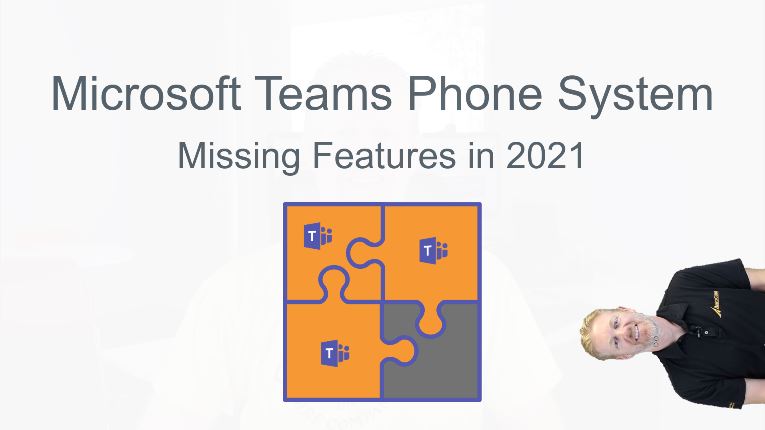Which features are missing from Microsoft Teams Phone System in 2021?
You’re researching Teams as a possible replacement for your company’s PBX, and you’ve heard Microsoft has some gaps in feature/functionality… but what does that mean?
In this video, Mike Smith reviews the missing features he sees are affecting mid-size companies, most often, and the vendors you can go to, to solve the problem.
Want Mike’s recommendations on the vendors your company should quote, for Teams Phone System Direct Routing as a Service (i.e. Calling Plans)? Click below and ask him today.

About Mike
Mike Smith is the Founder and President of AeroCom and has been helping companies with telecom and cloud services since 1999. He has been the recipient of numerous business telecommunications industry awards and in 2011, he was honored as one of the top 40 business people in Orange County, CA., under 40 years old. You can also hear him as the host of the popular Information Technology podcast, ITsmiths with Mike Smith. Follow Mike on LinkedIn, Twitter or SpiceWorks.
Transcript
So your company is in the market for a new phone system, and one of the options you’re looking at is Microsoft Teams phone system. But you’ve heard some rumors going around that it’s got some gaps in terms of features and functionality, and you’re wondering “Hey, what is it missing?”
Well, I wanted to make a quick video to kind of summarize some of the things that I see pop up most commonly.
Now if you were to list every single feature and functionality of any phone system, whether it’s Microsoft Teams or any cloud PBX product, it’d be impossible. You’d be listing several pages of features and functionalities, and call flow, little quirks and different things, ways you can organize users and all types of things. There’s no way I can cover every single thing.
Let me just tell you, after selling this product for a couple of years I can tell you what the most common things that pop up that are the most impactful it seems like to businesses that Microsoft Teams phone system is currently missing as I make this video in March 2021.

Call Center
First and foremost, it’s contact or call center feature functionality. Yes, Microsoft Teams phone system does have the ability to create call queues and have people sit on hold, and just the basic stuff. But where it’s lacking is the ability to have things like omnichannel. It’s also lacking the ability to barge in and monitor callers, and some of the more advanced call center analytics like time on hold and send an automatic alert to a manager when you see that certain hold threshold, wall boards, things like that.
That’s where Microsoft Teams phone system is lacking when it comes to call center. If your company needs any of that stuff, it might not be the best fit or you might need to add a third party vendor on top of Microsoft Teams to compensate for that.
Reception Console
Another thing Microsoft Teams is lacking in is, a reception console of any sort. They don’t have an ability to have a sidecar to the hardware that that’s available for Microsoft Teams phone system. They also do not have a reception soft console.
If that’s a big deal for your company, if you have a large company and you have a reception desk that currently needs to see all user status at all times so they can quickly route calls based on that, Microsoft Teams phone system may not be the best fit.
If a call comes in on Microsoft Teams phone system to your reception desk, they’re going to have to look up the user on Teams and then see their status. They don’t have a way to see the entire company at the same time whether it’s on a piece of hardware or whether it’s on a soft phone.
SMS & MMS
Something else Microsoft Teams phone system is currently lacking is the ability to send and receive text messages from your work phone number, like from your soft phone. It’s called SMS messaging. Right now, there’s a lot of cloud PBX providers out there who allow that. So, you don’t have use your cellphone. You can actually send and receive text messages from your work number using your cloud PBX soft phone.
Well Microsoft Teams phone system currently does not have that feature available. It’s asked about a lot, and it’s not quite there yet, although they say it is on the roadmap.
Analytics
An item that companies ask about a lot, especially if they’re a mid-size company or have a large sales organization is, Microsoft Teams does not have advanced analytics for the regular PBX functionality. I know we talked about analytics when it to call center, the Teams phone system also does not have a very robust set of analytics available for normal phone calls taking place.
For instance, if your sales manager wants to have a report emailed to he or she once a week that says all the sales people’s call volume for specific people in the office, and they want to have some pie graphs or charts done, they want to be able to really customize reports and have them emailed then to them on a regular basis, Teams does not have that ability nor do they have any really advanced or robust analytics available for day to day historical call reporting.
Integration with CRM & ERP Applications
A big item that is sometimes asked about with cloud PBX is the ability to integrate with other outside software outside the Microsoft family. For instance, Salesforce is obviously a big one. Companies want the ability to integrate their CRM with their phone system so that if a current customer is called or calls in, it automatically logs in activity in Salesforce or whatever CRM or ERP that they’re using.
It’s a very common feature for medium-sized companies, but Microsoft Teams phone system does not have an easy way to integrate with all those different software apps that are out there, where a lot of the large cloud PBX service providers do have out-of-the-box integrations with the most common CRM and ERP software.
Call Merge
Last but not least is what seems like a small feature, but a lot of companies actually use it quite often. It’s incoming call merge. Microsoft Teams phone system does not have the ability to merge an incoming call into your current call.
If you’re a phone call and another call comes in and you say, “Hey that’s Jim calling. I’d love to have Jim join this conversation and we could all talk about this together,” if Jim’s calling you, you cannot merge Jim into your existing call. That’s called incoming call merge. You cannot do that Microsoft Teams phone system, but you can do that with a lot of other cloud PBX solutions.
I hope that helps a little bit. To me, those are the most common I would say gaps in Microsoft Teams phone system for medium-sized companies in March 2021. Again, there’s more out there and there’s also a lot of good things that it can do. It definitely does all the basics.
I hope that was helpful. If so, make sure you hit the like button down below.
Recommendations
If you’d like some quotes, or you’d like to know which Microsoft Teams phone system direct routing as a service providers are the best fit for your business, don’t Google it. Actually, just contact me (email or call 714.593.0011). That’s my job. I’m a broker for all the major cloud PBX solutions, including all the vendors who do Microsoft Teams phone system.
I can get you quotes from not only one vendor, but several based on what your company’s requirements are… I’m kind of a little bit of a matchmaker for you for all the different best cloud PBX solutions, including Microsoft Teams. Don’t Google it for hours. Don’t waste your time doing that. Just call me.
The best news is, is these vendors actually pay my company our broker fee, so you don’t have to pay us a dime. So, there’s absolutely no excuse to try to figure this stuff out on your own. Just contact me and I’m happy to help.
I hope that video helped out a little bit about Microsoft Teams phone system, and if you have more questions feel free to reach out and I’ll catch you on the next one.






